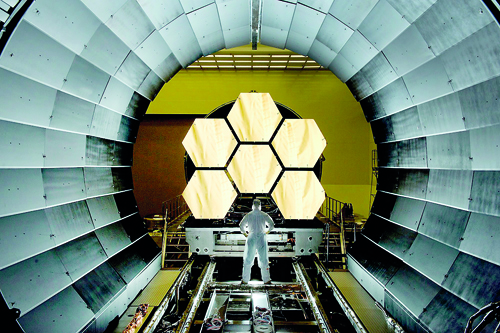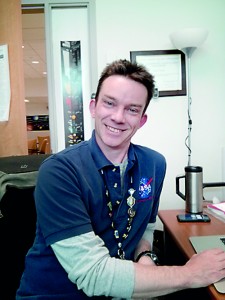In a pristine room with JWST
I never anticipated being quite so enthralled by the sight of a man vacuuming a spotless floor. It’s not just what he’s wearing – a white coverall with a hood – but the whole room around him. There’s nothing here in the way of interior décor – the worlds largest clean room is all function. Nestled inside the NASA Goddard Space Centre, High Bay is 1.3 million cubic feet of impeccably pristine space.

Telescope mirror segments undergoing cryogenic testing. Each mirror measures 4-3 feet. Pix- NASA/MSFC/David Higginbotham
9,000 square feet of HEPA filters make up an entire wall, through which some one million cubic feet of air is circulated every minute. All this so no dust will settle on the enormous golden hexagons parked on a two storey platform mere feet away from the window of the observation room. To many astronomy buffs, the chance to see the James Webb Space Telescope (JWST) being built would be deeply thrilling stuff. For astrophysicist Dr.Tilak Hewagama, this is simply where he goes to work.
Named after the father of modern rocket propulsion in the United States, the NASA Goddard Space Centre in Maryland isn’t the easiest place to get to, but Tilak makes the trip every other day from his home in Silver Springs. Even the most determined visitors seldom make it past the visitor centre and into the buildings beyond. To do so, I’ve had to apply for security clearance weeks in advance as well as complete courses on IT security and undergo GSFC-Hazard Communication Training online. However, I’m now a designated science collaborator and ridiculously pleased about it. Not least because of this opportunity to get up close and personal with JWST, hailed as the scientific successor to the venerable, much beloved Hubble Space Telescope.
With 72-foot long sunshield the size of a tennis court and a 21-foot mirror, JWST is due to launch in 2018, says Tilak, pointing to the models of the telescope displayed in the waiting area. He notes that JWST’s mirrors get their distinctive look from a thin covering of gold, which is itself protected by another layer of glass, optimising the instrument for infrared light. Seven times more powerful than the Hubble Space Telescope, this instrument will allow us to look back 13 billion years to see the ‘first light’ of the universe. Stationed 1.5 million kilometres away from our planet, poised at one of the five Lagrangian points, it will be a giant; the largest space telescope ever launched. It’s a pity, we won’t be there to see it deploy.
Delivered all folded up like an origami artwork in a payload capsule of an Ariane 5 heavy-lift rocket, JWST will unfurl gracefully out of its metal cocoon. (It’s why NASA hiring the voice of Optimus Prime to narrate one of their promotional videos was an inspired choice.) Its fuel storage capacity is expected to allow it to function for only a decade but it might be even less considering its many, unique operational challenges. For instance the side which faces the sun will reach temperatures of 85°C while the section which houses the mirrors and scientific instruments will be a freezing-233°C. Needless to say, lots of things could go wrong.
In recent months, NASA has created teams that are dreaming about how best to use the time they have with the telescope. Scientist Conor Nixon is the head of the group that’s making the case for a moon. He’s an old hand here at Goddard where’s he’s worked for over 14 years on the flagship Cassini-Huygens programme. The spacecraft, whose spectacular images of Saturn have shown us the planet in all its incredible beauty, has also allowed us to explore not just the gas giant itself but the extraordinary system of rings and moons that circle it. For his part, Conor has long been interested in one moon in particular.
Titan is absolutely fascinating for more than one reason – for one, liquid lakes exist on its surface, except these are made of methane. The methane even evaporates and forms clouds, plummeting back to the surface as rain. Second only to Jupiter’s Ganymede in size, Titan is bigger than all of Saturn’s 61 other moons combined. My very favourite fact is that a specific combination of thick atmosphere,

Conor Nixon
low gravity and just the right surface pressure mean that if someone strapped a pair of well-constructed wings onto you, you could, in theory at least, fly. Conor seems much more intrigued by the possibility that they could find the precursors of life while digging around there. “Some people think Titan is similar to the prebiotic Earth long ago, when the molecules were forming the basis of life,” he says. What would we find if we sent back even more sophisticated spacecraft?
Though it may not be able to do much more, Cassini can at least beat the Webb on some fronts. It can get much closer to Titan for starters, says Conor. When it comes to the Webb, “monitoring weather will probably be the most likely application,” he says, “it will be difficult to predict what happens until the telescope is actually launched. The telescope is a general purpose tool, and so it will be used for many, many things.”
Now, with anticipation rising for the Webb’s launch, Cassini is scheduled to meet a grisly, if magnificent end sometime in 2017.One can’t help but feel a pang for the faithful spacecraft which sent us those images of lightning storms on Jupiter, the plumes of liquid water erupting out of the surface of the moon Enceladus, and that awe-inspiring image of Earth as seen from Saturn. It has shown us such unimaginable beauty. But Cassini still has more to offer.
“The end of the mission is that we’re actually going to impact into Saturn,” says Conor. Using his board and a marker, he traces an orbit that will take Cassini closer than it’s ever been before, right inside the rings of Saturn, eventually ending in a suicide run into the heart of the gas giant, where crushing pressure awaits. “As you can imagine, this is going to be a very interesting part of the mission. We’re going to be so close to the rings, the pictures will be spectacular and also we’re going to be able to directly sample this region to find out what’s in there, actually sniff the gas, and measure the magnetic field. It’s going to be amazing.”


